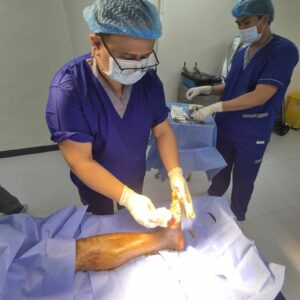Non-invasive ultrasound diagnostics have emerged as a game-changer in the world of healthcare, offering a safe, effective, and painless alternative to traditional imaging methods. By harnessing sound waves, ultrasound technology allows medical professionals to assess soft tissues, muscles, tendons, and joints in real-time, without the need for radiation or invasive procedures. Whether you’re recovering from an injury, managing chronic pain, or seeking a detailed diagnosis, non-invasive ultrasound is quickly becoming the go-to choice for many.
What Is Non-Invasive Ultrasound Diagnostics?
Non-invasive ultrasound diagnostics, commonly referred to simply as ultrasound imaging, is a medical procedure that uses high-frequency sound waves to produce detailed images of the body’s internal structures. Unlike X-rays or MRIs, ultrasound does not involve radiation or require contrast dyes, making it a safer option for patients.
This imaging technique is particularly useful for evaluating soft tissues like muscles, tendons, ligaments, and joints, providing real-time images that help doctors identify and assess conditions with greater accuracy. The non-invasive nature of ultrasound makes it a preferred diagnostic tool, allowing patients to avoid the discomfort and risks associated with more invasive procedures.
How Does Non-Invasive Ultrasound Work?
Ultrasound works by emitting high-frequency sound waves through a handheld device called a transducer. These sound waves travel through the body and bounce back when they encounter different tissues, creating echoes. A computer then processes these echoes to form detailed images of the internal structures.
One of the greatest advantages of non-invasive ultrasound is its ability to produce real-time imaging. This means that doctors and specialists can observe dynamic movements in the body, such as muscle contractions or joint motions, as they happen. This dynamic visualization is something static imaging methods like X-rays cannot provide, making ultrasound an invaluable tool for assessing functional movements and injuries.
Key Benefits of Non-Invasive Ultrasound Diagnostics
Non-invasive ultrasound diagnostics offer a range of benefits that make it an ideal choice for both patients and healthcare providers. Here are some of the key advantages:
Non-Invasive and Painless: Unlike traditional diagnostic procedures, ultrasound does not require incisions, injections, or exposure to radiation. This makes it an extremely safe option, particularly for individuals who may need frequent imaging, such as athletes or people with chronic conditions. The process is generally painless, with minimal discomfort, making it suitable for patients of all ages.
Real-Time Feedback: The ability to view live, real-time images of tissues in motion is one of the greatest benefits of ultrasound diagnostics. This allows healthcare providers to assess how tissues are functioning in real-time, making it easier to spot subtle injuries or abnormalities that might not be visible in still images. Whether it’s assessing joint movement or detecting muscle strain, real-time feedback ensures a more accurate diagnosis.
Accurate Diagnosis: Non-invasive ultrasound is highly effective at pinpointing the exact cause of pain or dysfunction. For example, it can help identify inflammation, tears, or degeneration in muscles, tendons, and ligaments. By providing clear, detailed images, ultrasound enables precise diagnosis, ensuring that treatment plans are tailored to each patient’s specific condition.
Faster Recovery: One of the key benefits of ultrasound is its ability to guide therapies, including injections, physical therapy, and manual therapy. By using ultrasound guidance, healthcare providers can target treatment areas with greater accuracy, improving the effectiveness of interventions and reducing recovery times. Whether it’s for a sports injury or chronic pain, ultrasound can help speed up the rehabilitation process.
Common Conditions Treated with Non-Invasive Ultrasound Diagnostics
Non-invasive ultrasound diagnostics are highly effective for diagnosing and treating a wide range of musculoskeletal conditions. Some of the most common conditions treated include:
- Rotator Cuff Tendinitis: Ultrasound can visualize the tendons in the shoulder, allowing healthcare providers to assess inflammation or damage.
- Plantar Fasciitis: Ultrasound helps evaluate the thickness of the plantar fascia ligament in the foot, enabling tailored treatments like shockwave therapy.
- Meniscus or Ligamentous Injuries: For knee injuries, ultrasound can pinpoint tears or strains in the meniscus and surrounding ligaments.
- Patellar Tendinitis: Known as “jumper’s knee,” ultrasound is used to examine the patellar tendon, helping doctors assess inflammation and guide therapies like injections.
- IT Band Syndrome: Ultrasound helps assess the iliotibial band, commonly irritated in runners, and guides treatments like anti-inflammatory injections.
Why Choose Non-Invasive Ultrasound for Injury Recovery?
For anyone recovering from a sports injury or musculoskeletal condition, non-invasive ultrasound is an invaluable tool in both diagnosis and rehabilitation. Its ability to provide real-time feedback allows healthcare providers to monitor progress and adjust treatment plans as necessary.
Ultrasound also plays a crucial role in guiding therapies such as corticosteroid injections, dry needling, and physical therapy exercises. With its precise imaging, ultrasound ensures that treatments are targeted directly to the injured area, which leads to faster healing and better outcomes. By using ultrasound in rehabilitation, patients can get back to their activities with greater confidence and less downtime.
The Future of Non-Invasive Ultrasound Diagnostics in Healthcare
As technology continues to advance, the capabilities of non-invasive ultrasound diagnostics are expected to expand even further. Innovations in ultrasound imaging technology are already making it more efficient, portable, and user-friendly. The potential for integrating ultrasound with other forms of diagnostic technology, such as artificial intelligence, is also on the horizon, promising even more precise and personalized care.
The continued development of ultrasound technology means that non-invasive ultrasound diagnostics will only become more essential in modern healthcare, enhancing both diagnostic accuracy and treatment effectiveness.
How to Get Started with Non-Invasive Ultrasound Diagnostics
If you’re experiencing a musculoskeletal injury, chronic pain, or simply need an accurate diagnosis, consider seeking non-invasive ultrasound diagnostics. Many healthcare centers and physical therapy practices, such as Optimal Performance & Therapy Centers of Indiana (OPTCI) in Fishers, IN, offer ultrasound diagnostics as part of their treatment plans.
Booking an appointment with a trained healthcare provider who specializes in ultrasound imaging ensures you receive the most precise diagnosis and targeted therapies tailored to your specific needs. Take the first step towards effective recovery today!
Takeaway
Non-invasive ultrasound diagnostics are transforming the healthcare landscape by providing accurate, real-time imaging without the need for radiation or invasive procedures. With its numerous benefits—such as fast recovery, pain-free diagnostics, and the ability to guide therapies—ultrasound is quickly becoming an essential tool for diagnosing and treating musculoskeletal injuries and conditions. Whether you’re recovering from an injury or seeking a comprehensive assessment, non-invasive ultrasound is a safe, effective, and reliable choice for modern healthcare.






